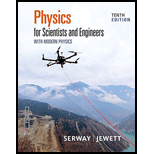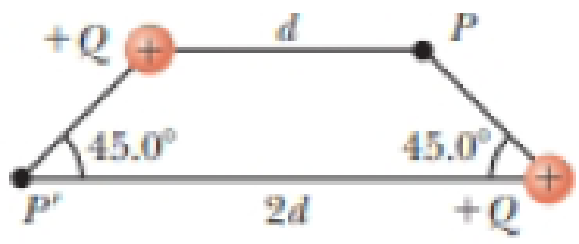
Physics for Scientists and Engineers with Modern Physics
10th Edition
ISBN: 9781337553292
Author: Raymond A. Serway, John W. Jewett
Publisher: Cengage Learning
expand_more
expand_more
format_list_bulleted
Concept explainers
Textbook Question
Chapter 22, Problem 17P
Two equal positively charged particles are at opposite corners of a trapezoid as shown in Figure P22.17. Find symbolic expressions for the total electric field at (a) the point P and (b) the point P′.
Figure P22.17

Expert Solution & Answer
Trending nowThis is a popular solution!

Students have asked these similar questions
two satellites are in circular orbits around the Earth. Satellite A is at an altitude equal to the Earth's radius, while satellite B is at an altitude equal to twice the Earth's radius. What is the ratio of their periods, Tb/Ta
Fresnel lens: You would like to design a 25 mm diameter blazed Fresnel zone plate with a first-order power of
+1.5 diopters. What is the lithography requirement (resolution required) for making this lens that is designed
for 550 nm? Express your answer in units of μm to one decimal point.
Fresnel lens: What would the power of the first diffracted order of this lens be at wavelength of 400 nm?
Express your answer in diopters to one decimal point.
Eye: A person with myopic eyes has a far point of 15 cm. What power contact lenses does she need to correct
her version to a standard far point at infinity? Give your answer in diopter to one decimal point.
Paraxial design of a field flattener. Imagine your optical system has Petzal curvature of the field with radius
p. In Module 1 of Course 1, a homework problem asked you to derive the paraxial focus shift along the axis
when a slab of glass was inserted in a converging cone of rays. Find or re-derive that result, then use it to
calculate the paraxial radius of curvature of a field flattener of refractive index n that will correct the observed
Petzval. Assume that the side of the flattener facing the image plane is plano. What is the required radius of
the plano-convex field flattener? (p written as rho )
Chapter 22 Solutions
Physics for Scientists and Engineers with Modern Physics
Ch. 22.1 - Three objects are brought close to each other, two...Ch. 22.2 - Three objects are brought close to one another,...Ch. 22.3 - Object A has a charge of +2 C, and object B has a...Ch. 22.4 - A test charge of +3 C is at a point P where an...Ch. 22.5 - Rank the magnitudes of the electric field at...Ch. 22 - Find to three significant digits the charge and...Ch. 22 - (a) Find the magnitude of the electric force...Ch. 22 - In a thundercloud, there may be electric charges...Ch. 22 - Nobel laureate Richard Feynman (19181088) once...Ch. 22 - A 7.50-nC point charge is located 1.80 m from a...
Ch. 22 - This afternoon, you have a physics symposium...Ch. 22 - Two small beads having positive charges q1 = 3q...Ch. 22 - Two small beads having charges q1 and q2 of the...Ch. 22 - Review. In the Bohr theory of the hydrogen atom,...Ch. 22 - Three point charges lie along a straight line as...Ch. 22 - A point charge +2Q is at the origin and a point...Ch. 22 - Prob. 12PCh. 22 - Review. Two identical particles, each having...Ch. 22 - Why is the following situation impossible? Two...Ch. 22 - Prob. 15PCh. 22 - Consider n equal positively charged particles each...Ch. 22 - Two equal positively charged particles are at...Ch. 22 - Two charged particles are located on the x axis....Ch. 22 - Three point charges are located on a circular arc...Ch. 22 - Two 2.00-C point charges are located on the x...Ch. 22 - Three point charges are arranged as shown in...Ch. 22 - Consider the electric dipole shown in Figure...Ch. 22 - Three equal positive charges q are at the corners...Ch. 22 - A proton accelerates from rest in a uniform...Ch. 22 - A proton moves at 4.50 105 m/s in the horizontal...Ch. 22 - Protons are projected with an initial speed vi =...Ch. 22 - You are still fascinated by the process of inkjet...Ch. 22 - You are working on a research project in which you...Ch. 22 - Consider an infinite number of identical...Ch. 22 - A particle with charge 3.00 nC is at the origin,...Ch. 22 - A small block of mass m and charge Q is placed on...Ch. 22 - A small sphere of charge q1 = 0.800 C hangs from...Ch. 22 - A charged cork ball of mass 1.00 g is suspended on...Ch. 22 - A charged cork ball of mass m is suspended on a...Ch. 22 - Three charged particles are aligned along the x...Ch. 22 - Two point charges qA = 12.0 C and qB = 45.0 C and...Ch. 22 - Two small spheres hang in equilibrium at the...Ch. 22 - Four identical charged particles (q = +10.0 C) are...Ch. 22 - Prob. 39APCh. 22 - Prob. 40APCh. 22 - Three identical point charges, each of mass m =...Ch. 22 - Prob. 42APCh. 22 - Two hard rubber spheres, each of mass m = 15.0 g,...Ch. 22 - Two identical beads each have a mass m and charge...Ch. 22 - Prob. 45APCh. 22 - Prob. 46APCh. 22 - Prob. 47APCh. 22 - Eight charged panicles, each of magnitude q, are...Ch. 22 - Two particles, each with charge 52.0 nC, are...Ch. 22 - Review. An electric dipole in a uniform horizontal...
Additional Science Textbook Solutions
Find more solutions based on key concepts
The method to determine the volume of a powered solid, liquid and a rock needs to be determined. Concept introd...
Living By Chemistry: First Edition Textbook
Give the IUPAC name for each compound.
Organic Chemistry
Separate the list P,F,V,,T,a,m,L,t, and V into intensive properties, extensive properties, and nonproperties.
Fundamentals Of Thermodynamics
Choose the best answer to each of the following. Explain your reasoning. If Earth were twice as far as it actua...
Cosmic Perspective Fundamentals
How could you separate a mixture of the following compounds? The reagents available to you are water, either, 1...
Organic Chemistry (8th Edition)
Knowledge Booster
Learn more about
Need a deep-dive on the concept behind this application? Look no further. Learn more about this topic, physics and related others by exploring similar questions and additional content below.Similar questions
- 3.37(a) Five free electrons exist in a three-dimensional infinite potential well with all three widths equal to \( a = 12 \, \text{Å} \). Determine the Fermi energy level at \( T = 0 \, \text{K} \). (b) Repeat part (a) for 13 electrons. Book: Semiconductor Physics and Devices 4th ed, NeamanChapter-3Please expert answer only. don't give gpt-generated answers, & please clear the concept of quantum states for determining nx, ny, nz to determine E, as I don't have much idea about that topic.arrow_forward3.37(a) Five free electrons exist in a three-dimensional infinite potential well with all three widths equal to \( a = 12 \, \text{Å} \). Determine the Fermi energy level at \( T = 0 \, \text{K} \). (b) Repeat part (a) for 13 electrons. Book: Semiconductor Physics and Devices 4th ed, NeamanChapter-3Please expert answer only. don't give gpt-generated answers, & please clear the concept of quantum states for determining nx, ny, nz to determine E, as I don't have much idea about that topic.arrow_forwardNo chatgpt pls will upvotearrow_forward
- Use the following information to answer the next question. Two mirrors meet an angle, a, of 105°. A ray of light is incident upon mirror A at an angle, i, of 42°. The ray of light reflects off mirror B and then enters water, as shown below: Incident ray at A Note: This diagram is not to scale. a Air (n = 1.00) Water (n = 1.34) 1) Determine the angle of refraction of the ray of light in the water. Barrow_forwardHi can u please solvearrow_forward6. Bending a lens in OpticStudio or OSLO. In either package, create a BK7 singlet lens of 10 mm semi-diameter and with 10 mm thickness. Set the wavelength to the (default) 0.55 microns and a single on-axis field point at infinite object distance. Set the image distance to 200 mm. Make the first surface the stop insure that the lens is fully filled (that is, that the entrance beam has a radius of 10 mm). Use the lens-maker's equation to calculate initial glass curvatures assuming you want a symmetric, bi-convex lens with an effective focal length of 200 mm. Get this working and examine the RMS spot size using the "Text" tab of the Spot Diagram analysis tab (OpticStudio) or the Spd command of the text widnow (OSLO). You should find the lens is far from diffraction limited, with a spot size of more than 100 microns. Now let's optimize this lens. In OpticStudio, create a default merit function optimizing on spot size.Then insert one extra line at the top of the merit function. Assign the…arrow_forward
- No chatgpt pls will upvote Already got wrong chatgpt answer .arrow_forwardUse the following information to answer the next question. Two mirrors meet an angle, a, of 105°. A ray of light is incident upon mirror A at an angle, i, of 42°. The ray of light reflects off mirror B and then enters water, as shown below: A Incident ray at A Note: This diagram is not to scale. Air (n = 1.00) Water (n = 1.34) Barrow_forwardUse the following information to answer the next question. Two mirrors meet an angle, a, of 105°. A ray of light is incident upon mirror A at an angle, i, of 42°. The ray of light reflects off mirror B and then enters water, as shown below: A Incident ray at A Note: This diagram is not to scale. Air (n = 1.00) Water (n = 1.34) Barrow_forward
- Good explanation it sure experts solve it.arrow_forwardNo chatgpt pls will upvote Asaparrow_forwardA satellite has a mass of 100kg and is located at 2.00 x 10^6 m above the surface of the earth. a) What is the potential energy associated with the satellite at this loction? b) What is the magnitude of the gravitational force on the satellite?arrow_forward
arrow_back_ios
SEE MORE QUESTIONS
arrow_forward_ios
Recommended textbooks for you
 Physics for Scientists and Engineers: Foundations...PhysicsISBN:9781133939146Author:Katz, Debora M.Publisher:Cengage Learning
Physics for Scientists and Engineers: Foundations...PhysicsISBN:9781133939146Author:Katz, Debora M.Publisher:Cengage Learning Physics for Scientists and EngineersPhysicsISBN:9781337553278Author:Raymond A. Serway, John W. JewettPublisher:Cengage Learning
Physics for Scientists and EngineersPhysicsISBN:9781337553278Author:Raymond A. Serway, John W. JewettPublisher:Cengage Learning Physics for Scientists and Engineers with Modern ...PhysicsISBN:9781337553292Author:Raymond A. Serway, John W. JewettPublisher:Cengage Learning
Physics for Scientists and Engineers with Modern ...PhysicsISBN:9781337553292Author:Raymond A. Serway, John W. JewettPublisher:Cengage Learning Principles of Physics: A Calculus-Based TextPhysicsISBN:9781133104261Author:Raymond A. Serway, John W. JewettPublisher:Cengage Learning
Principles of Physics: A Calculus-Based TextPhysicsISBN:9781133104261Author:Raymond A. Serway, John W. JewettPublisher:Cengage Learning College PhysicsPhysicsISBN:9781305952300Author:Raymond A. Serway, Chris VuillePublisher:Cengage Learning
College PhysicsPhysicsISBN:9781305952300Author:Raymond A. Serway, Chris VuillePublisher:Cengage Learning College PhysicsPhysicsISBN:9781285737027Author:Raymond A. Serway, Chris VuillePublisher:Cengage Learning
College PhysicsPhysicsISBN:9781285737027Author:Raymond A. Serway, Chris VuillePublisher:Cengage Learning

Physics for Scientists and Engineers: Foundations...
Physics
ISBN:9781133939146
Author:Katz, Debora M.
Publisher:Cengage Learning

Physics for Scientists and Engineers
Physics
ISBN:9781337553278
Author:Raymond A. Serway, John W. Jewett
Publisher:Cengage Learning

Physics for Scientists and Engineers with Modern ...
Physics
ISBN:9781337553292
Author:Raymond A. Serway, John W. Jewett
Publisher:Cengage Learning

Principles of Physics: A Calculus-Based Text
Physics
ISBN:9781133104261
Author:Raymond A. Serway, John W. Jewett
Publisher:Cengage Learning

College Physics
Physics
ISBN:9781305952300
Author:Raymond A. Serway, Chris Vuille
Publisher:Cengage Learning

College Physics
Physics
ISBN:9781285737027
Author:Raymond A. Serway, Chris Vuille
Publisher:Cengage Learning
Electric Fields: Crash Course Physics #26; Author: CrashCourse;https://www.youtube.com/watch?v=mdulzEfQXDE;License: Standard YouTube License, CC-BY